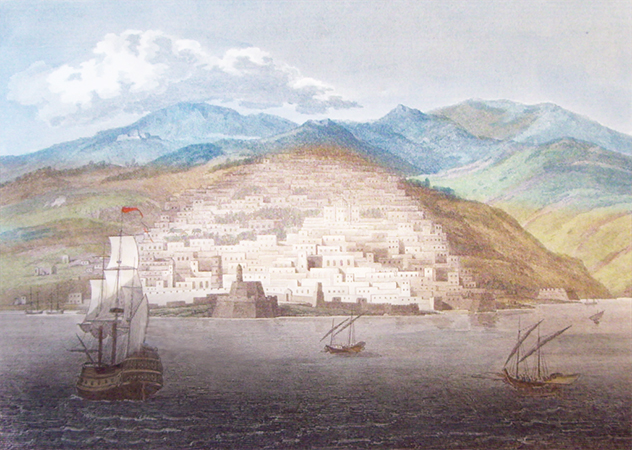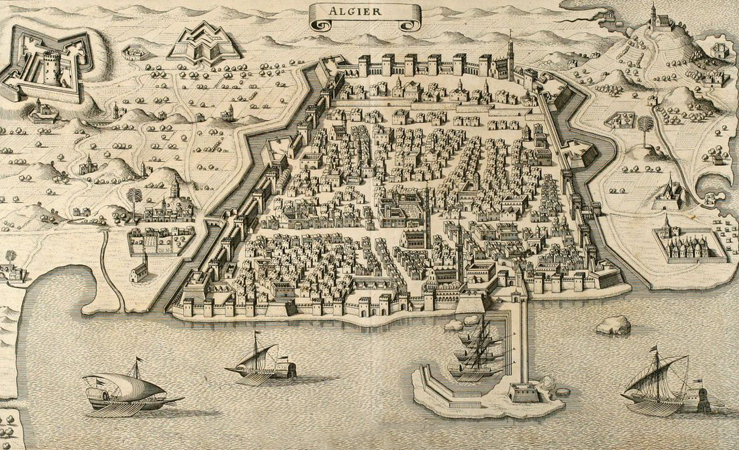Some weeks back, I posted a series of excerpts from Pierre Dan’s Histoire de Barbarie about the history of Algiers. This week begins a new series of posts about Algiers, this time about what the experience would have been like for European captives brought into the city.
— ⸎ —
During the first half of the seventeenth century, the Algiers corsairs took an average of something close to about 5,000 captives a year. In general, these captives lived or died in complete anonymity. Even those who were lucky enough—or tough enough—to survive and return home mostly left no trace.
Some, though, wrote about their experiences. There were also various European officials—Consuls, Special Envoys, friars from redemptionist religious orders—who spent time in Algiers and left behind written records.
This series of posts relies on this assortment of first-hand accounts, using descriptions from them to paint a picture of what Algiers was like for the European captives who were brought there.
We will trace what captives would have experienced, starting with their first glimpse of the city of Algiers looming menacingly on the horizon, to their stepping uncertainly ashore in the Algiers harbor, being sold like livestock at auction, and then having to endure painful servitude.
— ⸎ —
Seen from the sea, seventeenth century Algiers presented a quite spectacular sight. The city was located on the northwestern horn of a large bay—10 miles/16 kilometers across—ringed by verdant mountains. The buildings of the city ascended a mountain slope, tier after tier, up from the harbor to the mountain’s crest, 4,000 feet/120 meters above sea level. Every structure was whitewashed frequently, so that they all gleamed brightly in the sun. More than one writer described this mass of whitened buildings, framed by luxuriant green mountains, as resembling a glittering diamond in an emerald setting (see the illustration at the top of this post).
As captives approached Algiers, they were likely not in any state of mind to appreciate such a wondrous sight. Most of them probably never got a chance to witness it in any case, for they would have been kept chained up belowdecks as the corsair ships carrying them approached the city. Anybody who might have been on deck, however, would have observed the white, gleaming lozenge of the city in its green frame emerge in the distance when the bay came into view. As the ship drew closer, the tiers of brilliantly white buildings would seem to rise up out of the sea, higher and higher, until they completely dominated the shoreline—a human-made alabaster mountain more than a kilometer high. Most captives would never have seen anything even remotely like it.
— ⸎ —
When corsair ships carrying captives entered the bay, they passed by an island fortress bristling with cannon. A mole—a long, rocky causeway extending for about 1,000 feet/300 meters—connected this fortress with the city itself and served as a breakwater to create a sheltered harbor (see the illustration below).
This mole was a serious piece of marine architecture. João Mascarenhas, a Portuguese soldier who was enslaved in Algiers from 1621 to 1626, described it like this:
The mole is very well constructed, so high that it covers the tops of the ships
it houses, and so big that every ship can moor close enough to it to store ballast,
artillery, and barrels of water on the mole itself and still leave plenty of room for
people to pass… All along it are small columns where one can moor a ship….
It can shelter eighty ships, six galleys, four brigantines, and many saetes, tartanes,
and polacres.[1]
As corsair ships returning from a successful expedition rounded the mole and entered the protected waters of the port, they fired off a celebratory cannonade. Mascarenhas wrote that the fleet of corsair ships carrying him and other Portuguese captives announced its triumphal arrival with “banners flying, trumpets blaring, and salvos of artillery.”[2] The more successful the expedition, the more exuberant the cannonade.
The inhabitants of Algiers would have responded immediately—and enthusiastically.
Francis Knight, a young English merchant who was enslaved in Algiers in the 1630s, wrote that when a successful corsair expedition he was part of—he was a slave chained to a rowing bench on a galley—drew into the Algiers harbor, it was greeted with “acclamations of joy by the inhabitants, all the house tops being covered with women crying, “Allaluah! Allaluah!” with salutations of cannons and a general rejoicing of the people.”[3]
Not only would cannon fire have thundered out enthusiastically from the shore batteries in response to the shipboard salvos, but a great crowd of excited people would have mobbed the harborfront and spilled out onto the mole in noisy anticipation.
This general excitement was a standard reaction to the arrival of any successful corsair expedition. It was motivated by a number of factors. Prominent among them was profit, for the main economic driver of Algiers during this period was piracy: the violent capture by Algerian corsairs of goods and people and their subsequent resale—on a grand scale.
For generations, oared galleys, rowed mostly by slaves, had been the mainstay of the Algiers fleet. Thanks to the influx of European renegades in the early decades of the seventeenth century, however, these galleys were mostly (though not entirely) replaced by square-rigged, European-style sailing ships.
By the late 1620s, the Algiers corsair fleet included somewhere between seventy and eighty square-rigged sailing ships, each mounting twenty-five cannons or more, a dozen or so galleys of varying sizes, and a horde of smaller ships of all sorts (including saetes, tartanes, and polacres).
With large, square-rigged sailing ships now at their disposal, Algerian corsairs hunted a hugely expanded swath of territory, including not only the whole of the Mediterranean but also the waters all along the Atlantic littoral of Europe. During the corsair season—typically late April to early October—they hunted indefatigably, a swarm of ships, large and small, bringing back an enormous haul of booty and captives every year.
[1] Esclave à Alger: récit de captivité de João Mascarenhas (Enslaved in Algiers: the Story of the Captivity of João Mascarenhas), a translation by Paul Teyssier of the original Portuguese narrative by João Mascarenhas, Memorável Relação da Perda da Nau Conceição (A Memorable Account of the Loss of the Ship Conceição), first published in 1627, pp. 80-82. “Saetes,” “tartanes,” and “polacres” are types of small to medium-sized sailing ships.
[2] Esclave à Alger, p. 54.
[3] Francis Knight, A Relation of Seven Years Slavery Under the Turks of Algier, Suffered by an English Captive Merchant, p. 10.
____________________
For the next installment of this series of posts on Algiers, see the next post here in this blog.
 The Travels of Reverend Ólafur Egilsson
The Travels of Reverend Ólafur Egilsson
The story of the Barbary corsair raid on Iceland in 1627
Amazon listing
